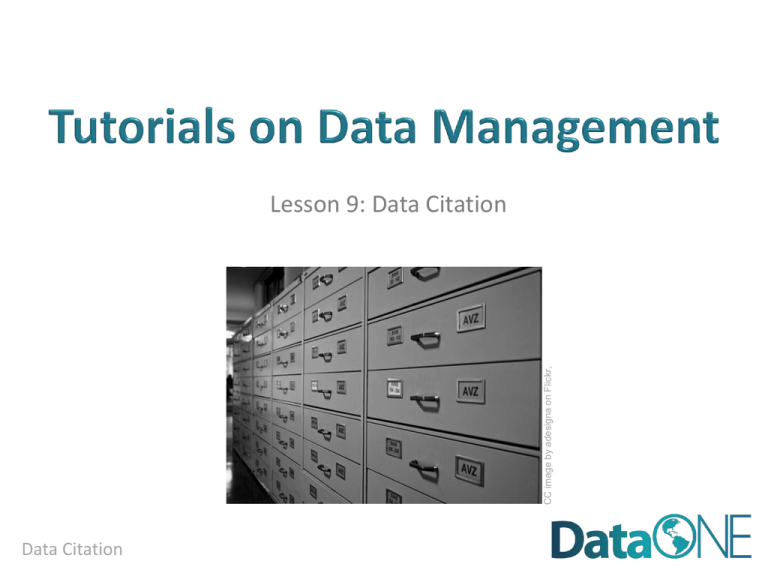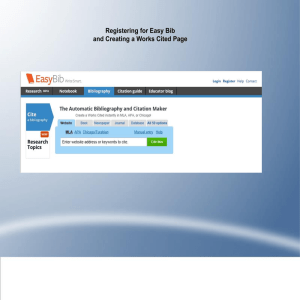
CC image by adesigna on Flickr,
Lesson 9: Data Citation
Data Citation
Data Citation in the Data Life Cycle
Definitions: What is Data Citation?
Benefits of Data Citation
Collaborating to Support Data Citation
How to Cite Data
How to Obtain a Persistent Identifier for
a Data Set
• Best Practices to Support Data Citation
Data Citation
CC image by cybrarian77 on Flickr,
•
•
•
•
•
•
• After completing this lesson, the participant will be able to:
o Define data citation
o Describe benefits of data citation
o Identify roles of data authors/managers, data publishers, and journal
publishers in supporting data citation
o Recognize metadata elements useful for data citation
o Recognize common persistent data locators and describe the process
for obtaining one
o Summarize best practices for supporting data citation
Data Citation
Plan
Analyze
Collect
Integrate
Assure
Discover
Describe
Preserve
Data Citation
• Data citation
o “The practice of providing a reference to data in the same way as
researchers routinely provide a bibliographic reference to printed
resources”1
o “A key practice underpinning the recognition of data as a primary
research output rather than as a by-product of research”1
• Data author
o “Individual involved in research, education, or other activities that
generate digital data that are subsequently deposited in a data
collection”2
• Persistent identifier
o A unique web-compatible alphanumeric code that points to a resource
(e.g., data set) that will be preserved for the long term (i.e., over several
hardware and software generations)
o Should direct to latest available version of resource or to metadata
which enables acquisition of desired version or format
Data Citation
o Facilitates discovery of
relationships between data
and publications, therefore
making it easier to validate
and build upon previous
work
o Ensures that proper credit
can be given when others
use your work
o For researchers searching
for data, link to publication
provides information about
related methodology and
allows data to be put into
context
Data Citation
CC image by futureatlas.com on Flickr,as “Citation Needed”
• Short term
o Allows an ability to
estimate the impact of a
particular dataset based
on number of publications
that cite the data
o Links to other publications
that cite a particular
dataset helps researchers
re-using data to find other
ways the data has been
used and how it is
regarded.
Data Citation
CC image by futureatlas.com on Flickr,as “Citation Needed”
• Short term
o Adoption of practices that
rely on publishing
infrastructure ensure data
will be available in the
future
o Less danger of ‘stealing’
because citable data must
be cited or treated as
plagiarism
o Easier to discover existing
data relevant to a
particular question
o Can be used as the basis
for measuring impact of
datasets or data
contributors
Data Citation
CC image by gruntzooki on Flickr
• Long term
o Enables recognition of
scholarly effort in
disciplines and
organizations that want to
recognize such effort
o Increase in the quantity
and quality of data
published
o Increased transparency of
scientific research
o Increased rate of scientific
research
Data Citation
CC image by gruntzooki on Flickr
• Long term
• Requires participation of a
o Journal publishers
o Data publishers/repositories
o Data authors
o Data managers
o Data users
o Professional organizations
Data Citation
CC image via Wikimedia Commons (Masur,
derivative of Al Maghi)
variety of individuals and
institutions
• Data authors and managers should
o Choose appropriate repository for data
publication
o Use common standards for data and metadata
o Work data up to publication standard
o Obtain citation information from data
publisher and include it in associated paper in
accordance with journal’s citation standards
o Include citations for any prior datasets used in
research
o Notify data publisher (e.g., data center or
repository) about associated paper(s)
Data Citation
o Ensure that data and metadata remain
static over time
• Digital preservation policy
• Versioning strategy
o Assign persistent and unique identifiers so
that data are discoverable
o Ensure published data remain accessible
• Restricted access in the case of sensitive,
commercial, or obsolete data
o Provide citation information that can be
included with papers associated with the
data
o Include a link to related publications as part
of metadata
Data Citation
Image courtesy of
http://www.mesothelioma-lawyersblog.com
• Data centers or distributors should
o Provide clear guidance on how
and where data sets should be
cited
o Be sensitive to wishes of
funding agencies when
suggesting or mandating
specific data repositories
o Alert data publisher when
publishing a paper that cites a
data set
Data Citation
CC image by the.Firebottle on Flickr
• Journal publishers should
• Similar to citing a published
article or book
o Provide information necessary to
• Broadly-applicable data
citation standards have not
yet been established; use
standards adopted by relevant
academic journal, data
repository, or professional
organization
Data Citation
CC image by walknboston on Flickr
identify and locate the work cited
• Author/Principal Investigator/Data Creator
• Release Date/Year of Publication – year of release, for a
•
•
•
•
•
completed dataset
Title of Data Source – formal title of the dataset
Version/Edition Number – the version of the dataset used in
the study
Format of the Data – physical format of the data
3rd Party Data Producer – refers to data accessed from a 3rd
party repository
Archive and/or Distributor – the location that holds the
dataset
Data Citation
• Locator or Identifier – includes Digital Object Identifiers
•
•
•
•
•
(DOI), Handles, Archival Resource Key (ARK), etc.
Access Date and Time – when data is accessed online
Subset of Data Used – description based on organization of
the larger dataset
Editor or Contributor – reference to a person who compiled
data, or performed value-added functions
Publication Place – city and state and country of the
distributor of the data
Data within a Larger Work – refers to the use of data in a
compilation or a data supplement (such as published in a
peer-reviewed paper)
Data Citation
•
DataCite: Creator
(Publication Year): Title.
Publisher. Identifier
Dryad: Author (Date of
Article Publication) Data
from: Article name. Dryad
Digital Repository. doi: DOI
number
Data Citation
CC image by Paxsimius on Flickr
•
• Earth Science Information Partners (ESIP):
o Required citation elements: Author. Release date. Title. Version.
Archive/Distributor. Locator/Identifier. Access date and time.
o Optional citation elements: Subset Used; Editor, Compiler, or
other important role; Distributor, Associate Archive, or other
Institutional Role; Data Within a Larger Work
o Example citation:
• Zwally, H.J., R. Schutz, C. Bentley, J. Bufton, T. Herring, J. Minster, J.
Spinhirne, and R. Thomas. 2003. GLAS/ICESat L1A Global Altimetry
Data V018, 15 October to 18 November 2003. National Snow and Ice
Data Center. Data set accessed 2011-07-21 at
doi:10.3334/NSIDC/gla01.
Data Citation
A persistent identifier should be included in the citation:
• DOI (Digital Object Identifier)
o Globally unique, alphanumeric string assigned by a registration agency to
identify content and provide a persistent link to its location.
o May be assigned to any item of intellectual property that is defined by
structured metadata
o Examples:10.1234/NP5678, 10.5678/ISBN-0-7645-4889-4;
10.2224/2004-10-ISO-DOI
• ARK (Archival Resource Key)
o URL designed to support long-term access to information objects
o Can refer to digital, physical, or intangible objects or living beings and
groups
o Example: http://ark.cdlib.org/ark:/13030/tf5p30086k
Data Citation
More persistent identifiers:
• UUID (Universally Unique Identifier)
o ‘practically unique’ identifiers that can be generated by distributed systems
but later combined into a single database without needing to resolve
identifier (ID) conflicts
o 32 hexadecimal digits, displayed in five groups separated by hyphens, in the
form 8-4-4-4-12 for a total of 36 characters
o Example: 550e8400-e29b-41d4-a716-446655440000
• Researcher identifier: ORCID (Open Researcher & Contributor ID)
o Central registry of unique identifiers for individual researchers to address
author name ambiguity
o Transparent linking mechanism between ORCID and other author ID
schemes
Data Citation
• Contact organization/institution that can create DOIs
o Organization hierarchy
x
x
x
x
UCSB Libraries
DOI Foundation
California Digital Library
(EZID)
X
X
DataCite
NCEAS
x
x
o 20+ services registered through DataCite include
• California Digital Library’s EZID
• ANDS Cite My Data Service
• DataCite Canada
Data Citation
• Provide data and necessary
citation profile (metadata)
o DataCite: creator, title,
publisher, publication year
o Dublin Core: creator, title,
publisher, date
o ERC: who, what, when
o Additional information:
owner, owner group, coowners
• Receive DOI to be used for
citation purposes
Data Citation
• To support access to your data:
o Use application that supports metadata creation for
environmental data sets
• Morpho
• Metavist (USDA Forest Service)
• Mermaid (NOAA)
o Use standardized keywords to describe your data
• Biocomplexity Thesaurus (USGS)
• Global Change Master Directory (NASA)
o Use a persistent identifier such as DOI or ARK
Data Citation
• Work with journal publishers and data repositories to archive
data during the publication process
o Allows information about how to access your data set to be published
with your article
•
Note: Data repositories typically offer to embargo archived data for a
pre-determined time period after publication
o Allows article citation/DOI to be included with archived data set
• Encourage other data authors to cite data and to make their
own data available for reuse:
o Provide full citation information for data whenever you publish work that
makes use of another author’s data
o Archive your own data in a repository that supports data discovery and
reuse
o Update your archived data sets when newer versions are available
Data Citation
1.
2.
3.
4.
5.
6.
Australian National Data Service (ANDS), Data Citation Awareness Guide.
Accessed May 10, 2012 at http://ands.org.au/guides/data-citationawareness.html.
National Science Board (2005). Long-Lived Digital Data Collections: Enabling
Research and Education in the 21st Century. Accessed May 10, 2012 at
http://www.nsf.gov/pubs/2005/nsb0540/.
Hakala, J. Persistent identifiers – an overview. Accessed May 10, 2012 at
http://metadaten-twr.org/2010/10/13/persistent-identifiers-an-overview/.
Ball, A. & Duke, M. (2011). How to Cite Datasets and Link to Publications.
DCC How-to Guides. Edinburgh: Digital Curation Centre. Available online:
http://www.dcc.ac.uk/resources/how-guides.
Costello, M. J. (2009). Motivating Online Publication of Data. BioScience,
59(5):418-427. Accessed May 10, 2012 at
http://www.bioone.org/doi/full/10.1525/bio.2009.59.5.9.
ESIP Federation Interagency Data Stewardship/Citations/Provider
Guidelines. Accessed May 10, 2012 at
http://wiki.esipfed.org/index.php/Interagency_Data_Stewardship/Citations
/provider_guidelines.
Data Citation
The full slide deck may be downloaded from:
http://www.dataone.org/education-modules
Suggested citation:
DataONE Education Module: Data Citation. DataONE. Retrieved
Nov12, 2012. From
http://www.dataone.org/sites/all/documents/L09_DataCitation
.pptx
Copyright license information:
No rights reserved; you may enhance and reuse for
your own purposes. We do ask that you provide
appropriate citation and attribution to DataONE.
Data Citation






